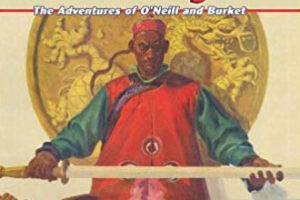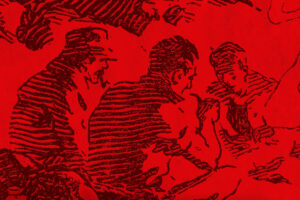 Victor Rousseau Emanuel (1879-1960) was a prolific pulp author who is largely overlooked today.
Victor Rousseau Emanuel (1879-1960) was a prolific pulp author who is largely overlooked today.
After writing for a variety of outlets, including newspapers, he gravitated to the pulps early on. He wrote under several names, early on settling on “Victor Rousseau.” Science fiction and fantasy, along with historical fiction, were he focus at first, though later on he wrote heavily for the Spicy pulps.
He created and wrote the first dozen or so Jim Anthony stories. Those and some of his pulp sf has been reprinted in recent years, though several of his major works are un-reprinted. His Draught of Eternity was reprinted in Steeger Books‘ Argosy Library, and now we get Eric of the Strong Heart, an early “lost-world/lost-race” novel.
Eric of the Strong Heart was originally published in four parts in Railroad Man’s Magazine in 1918. I thought its inclusion there strange as railroads play no part in the story! As I’ve read several lost-world stories over the years, this one is different in many ways.
The main character of the novel is Eric Silverstein. He was orphaned at a young age when his mother passed, and has never known his father. A scholarly type who doesn’t consider himself a hero or a man of action or even good looking, Eric meets a strange woman being exhibited in New York. She speaks an early version of English that few understand, and is accompanies by a giant and a dwarf. He learns she is Princess Editha from Rangarok.
Rangarok (no, I didn’t misspell it) is an unknown land in the Arctic, warmed by the Gulf Stream. It’s inhabited by three races. There are the Anglians, an Anglo-Saxon group who are Christian and ruled by Editha’s father. There are the Danes, who worship the Norse gods, including Odin and Loki, and who subjugate the Anglians. They are ruled by King Harald, who we learn came from the outside world. The third race are the “trolls”, a race of dwarfs who seem to have some kind of magical powers, which may just be a form of hypnotism. They seemed dominated by a witch, who apparently is several hundred years old.
Eric feels he is not fit to marry Editha, and thinks his good friend Ralph Wiston from college is the man for her. So he mounts an expedition to Rangarok with Ralph, joined by Bjorn. Things are complicated by the fact that Editha is under the spell of the witch, which can’t be broken unless Odin’s sword is pulled from its scabbard. There is a prophecy of men from the outside coming, which will spell the end of Rangarok (or is that Ragnorak?).
Will Ralph become the new king and wed Editha? Or will Eric? Will the curse be lifted from Editha? And if King Harald is also from the outside world, what does that foretell?
In many ways this was not the typical lost-world story. The hero of the story seems set on having someone else be the hero, until finally he becomes the hero. Characters who I figured would be more secondary to the story become more prominent. In some ways how the story plays out is not what I expected, based on other lost-world stories.
Rousseau wrote other works that either haven’t been reprinted, or have been reprinted but are not easily available. A trio of collections of his works was put out by Spectre Library in 2006-09, but are now out of print. His most well-known work may be The Messiah of the Cylinder. Another lost-world story of his that hasn’t been reprinted is My Lady of the Nile, originally from Argosy. And others that might good candidates for inclusion in future Argosy Library volumes include Fruit of the Lamb (sort of “I Dream of Jeannie”) and The Eye of Balamok (a hollow earth tale).




“… originally published in four parts in Railroad Man’s Magazine in 1918.” I guess railroad men need a little escape literature once in a while, just like the rest of us!
Yup. I was actually surprised by the total lack of anything to do with railroads in this story.